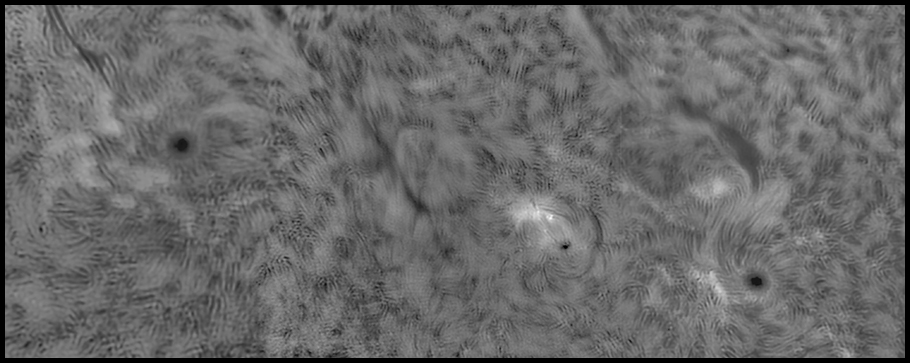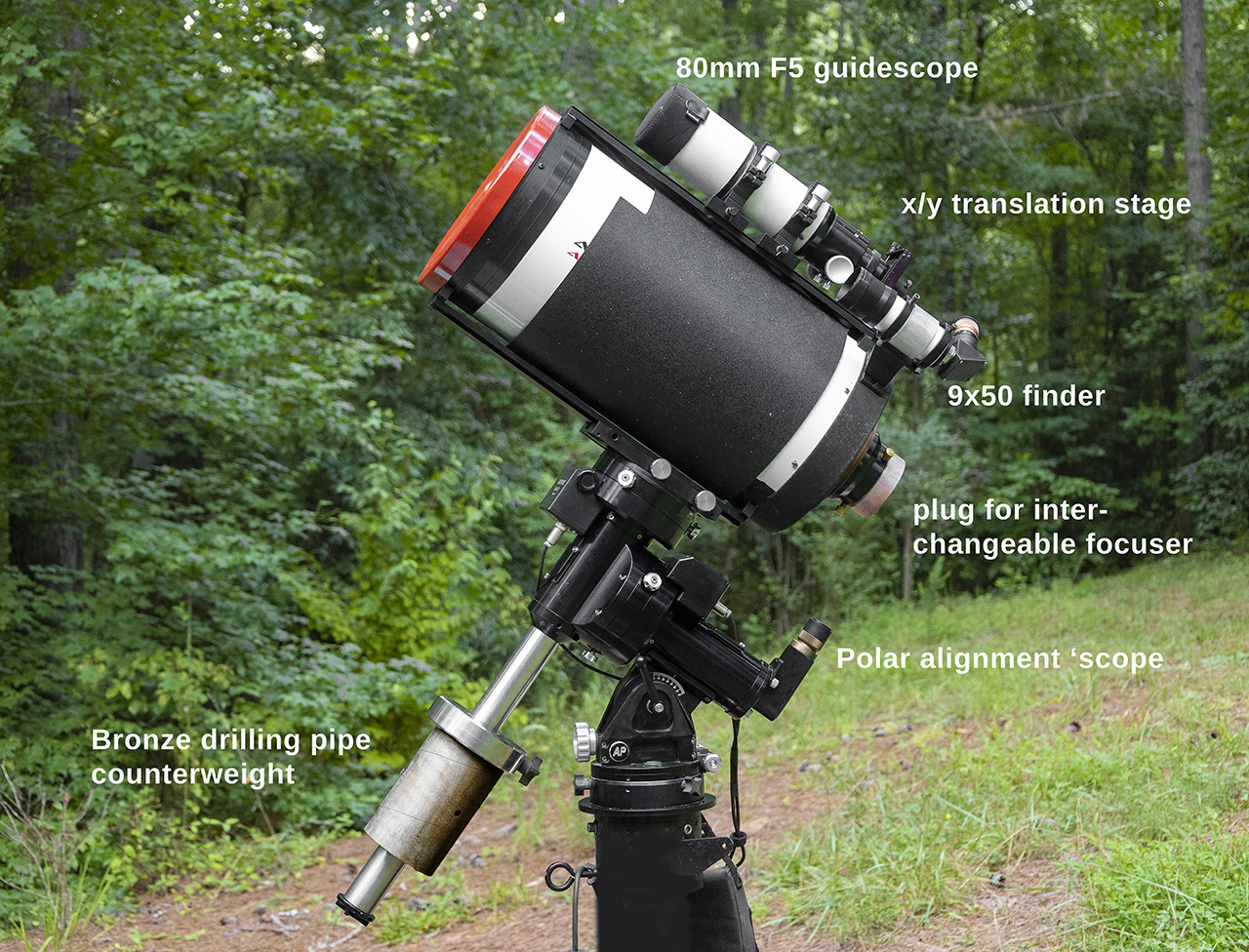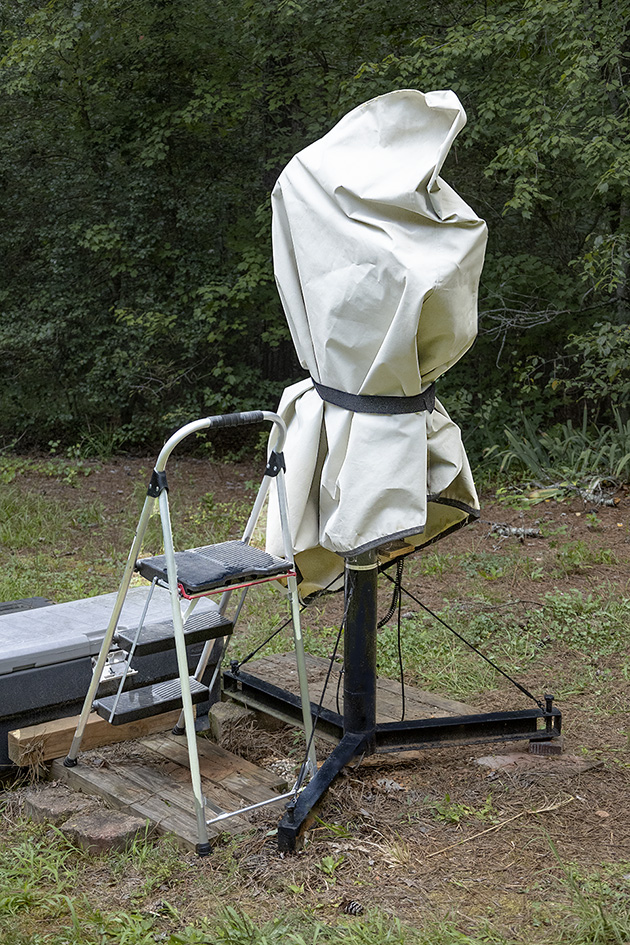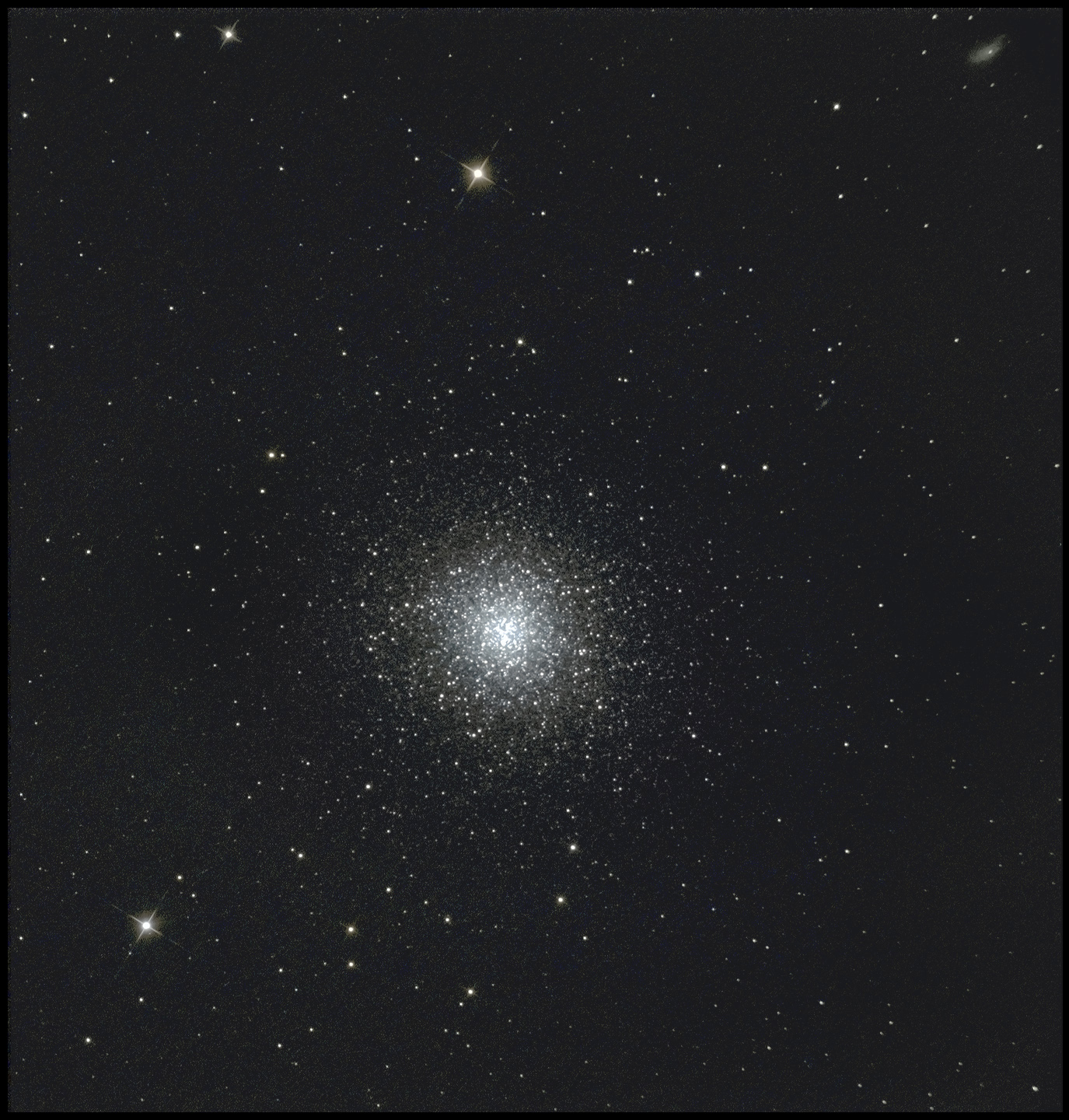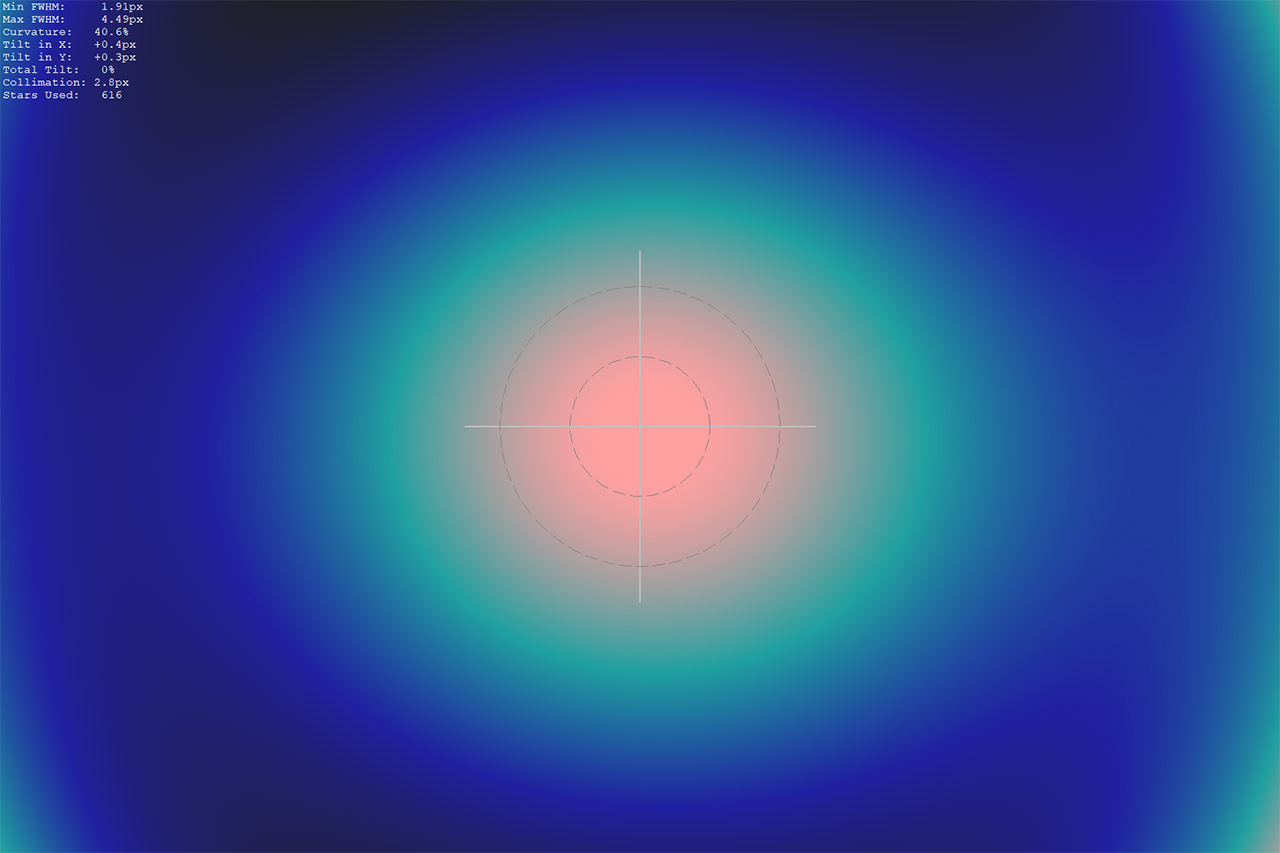The Starry Night, 227 :: home :: |
Day Two
I remounted the solar scope on the A-P mount. Tracking was perfect; imaging is not. Sungazing should've worked better than it did yesterday when I blame poor focus, excitement, and poor seeing. Today's is better, but this result is not as good as what I was getting just a couple of weeks ago. Something is a little off. Working on it. (8/16/2022: See page 103 under "Staring at the Sun" for the probable fix. I bet it's a complete cure, though some tweaking of the tilt mechanism probably remains to be done.)
Best 400 out of 3,000 frames x 3
8/11/2022. The 10-inch R-C is on the mount. I hemmed and hawed about moving it out there tonight, but why not? Here's an annotated guide to what's what, but some issues remain. There are a lot of things to be tried out yet.
At least for a while, the Orion Short-tube 80 (FL 400mm) will serve as a guidescope. I can reach for an off-axis guider if needed or revert to the much lighter guidescope (FL 160mm) I use with the TMB92 if its weight and differential flexure are the problems de jure. An X/Y stage on the guidescope replaces the usual collimating rings in the interests of stiffness. An aluminum plate / silica gel packet plug stands in for the focuser on the R-C. In use, the R-C will share the Feathertouch focusser from the TMB92 (I'm counting on never wanting to image with both instruments simultaneously -- in any event, not wanting to do so badly enough to pay for two focusers). Now that I think about it, that's probably a 9x60 finder rather than a 9x50, but who's counting? Pay no attention to the arrangement of counterweights: in the photo, they're set to balance everything without the guidescope in place (it's not light). After this, I added another steel cwt and moved everything up the bar a bit; in finished form, the counterweights come in around 35-40 pounds. It ought to be possible to replace the guidescope with the TMB92 or the solar frankenscope with only minor changes to the counterweight bar (ETA: just so). I've cobbled up the Losmandy D-saddles needed to mount either one.Stay tuned. Before trying out clear-weather options, there are foul-weather concerns. I confess that I am still considering roll-off and rollaway schemes. in the meantime, here's the freshly cleaned and re-waterproofed Telegizmos solution:
The stepladder is because the top of the telescope is just that little bit out of reach for me in Astro-Physics's Park 3 position (the one shown above).
8/13/2022. Tonight I found the best focus positions for the 10-inch R-C and for the 80mm guide-scope. I used the R6 for what was mostly a plausibility check (but I had to try for a pretty picture, too). I also wanted to align the finder- and guide-scopes, and I got that done, but I did not get to refine the polar alignment under the added weight of the R-C and its accessories. I simply ran out of clear skies. I still need to see about using the 0.67x A-P telecompressor and try the ASI1600 behind my biggest glass. I'll try inserting a diagonal in the X/Y stage behind the guide-scope to shorten the extension of the focuser and camera body. And I need to poke around to define a new profile for the 80mm guidescope. PHD2 did its best with what it knew, and it worked, mostly, but it can do much better. The R-C could stand to be recollimated, but it's not so far out that that is my first concern. In fact, it's in pretty good shape, see below.
23x10s, unguided.
There's no knock-out difference between a single 30-second guided exposure at ISO 6400 and a stack of 23 unguided 10-second exposures at ISO 3200 tonight (the single image is noisier, of course, but not fatally so). I picked the stack to show off because it includes the galaxy at upper right, and the single 30-second exposure was not framed to include it. The image shows about half the sensor's real estate. I cropped it for composition and to avoid vignetting. I didn't take any darks or flats. It's worth comparing this image to the previous one (92mm aperture vs 254mm, 50 minutes exposure vs 4 minutes). Click here to open a window on the previous effort. The limiting magnitude is slightly deeper with the 10-inch at 4 minutes; resolution and scale are very different. If they weren't, I'd be worried. I pulled one of the 10-second exposures into CCD Inspector. I suspect that the presence of the cluster and blended stars in it confuse the field curvature results more than a little, but tilt and collimation look pretty much spot on:
The morning after: I added new guider profiles in PHD2. To the one added long ago (50/163mm), I added two more, one for the 80/400mm guidescope and one approximating an OAG behind the RC10 which ought to be suitable with or without compression (I used 1,500mm for the focal length). Some tweaking is in order, but isn't it always? Clouds are in the forecast forever. Let's work on the boat.
08/23/2022. I aligned on Arcturus. The CP3 showed me the star in the finder 'scope even through clouds and twilight. Then I found it in the RC10 and R6, brought it dead center and recalibrated the drive. After the sky got a little darker, I focussed with the star offset in the field using the Bahtinov mask (the R6 comes to focus at the RC10's native FL with the Feathertouch extended about 56mm). Then I brought Arcturus into view in the guide 'scope. The 120MM Mini comes to focus behind a 1.25-inch diagonal in the X/Y stage only a few mm from all the way in, which is good and stable and easily preset. I had the mount slew to M101. PHD2 calibrated without any problem at all and started guiding using a fresh profile for the ShortTube 80 guidescope. And then, what the hell, clouds or no, I set the R6 to ISO 1600 and began taking 30-second exposures. Guiding is in the 0.4 second range in both axes on a star that is no brighter than magnitude 8.5 which PHD2 chose, through clouds. Pretty impressive to me. PHD2 reports a S/N of 10-18 using 4 second, dark-subtracted guide frames. So far, so good. I'm going to let the field run down toward the trees and maybe pick up another target after the clouds blow through (ClearSkyClock says I should have a decent window later). Results 000: There are definitely spiral arms, star clouds, etc even in the low-contrast image the clouds allowed. Subs could be longer and the sky will permit more gain. I tossed about half the frames (almost no stars) and stacked 14 minutes worth of exposure. Except I missed. The core of the galaxy was right on the edge of the field and its extensive arms reached into one side of the frame. When I slewed to M13 just for drill, it was also far off to one side. Have I forgotten how to recalibrate? It's too simple to screw up. Is the polar alignment that bad? I wouldn't think so, but maybe it needs to be better than I suspected for slewing around like this. And I did the original alignment using a lighter, shorter OTA. Something may have shifted while loading the mount, and the alignment might not have been all that excellent to start with. Satellite overview says an interval of clear skies will arrive later tonight. Stand by. I got another dozen frames in, through some thinner clouds in a sky full of denser ones. I slewed to, centered, and recalibrated on Vega, then slewed to M56. The target was off center again, but not as bad as M101 and M13 were. It was a much shorter slew from Vega. So at least this is consistent. Recheck polar alignment. It has to be polar alignment. And I should sync rather than just recalibrate on some target. Want reassurance? Slew elsewhere, anywhere, and then come straight back to the original target. If the soft- and hardware is not somehow off, then I ought to find the original target centered -- polar alignment shouldn't matter for that test. Yeah well... when I went out to check the balance of the AT10RC and guidescope the next morning, I discovered that one RA clutch was finger-tight and the others were not even that. I bet that might have something to do with slewing accuracy. I updated PHD2 from v2.6.9 to v2.6.11 for multi-star guiding. More about everything when I know more.
:: top ::
|
|||
© 2021, David Cortner
